Updated November 2023.
Whether you’re a seasoned PPC advertiser or you’re just getting started, there’s always room to explore alternative ad channels to grow your business, and often the cheapest ad networks are overlooked.
While Google Ads may remain the most popular PPC network, it’s also among the most expensive. Naturally, this is hardly ideal if you plan to increase your ROAS (Return on Ad Spend) or simply tighten the purse strings.
With that in mind, it pays to consider some great alternative ad networks to ensure that your business gets the most bang for its proverbial buck.
The only question is, which one do you choose? In this article, we’ll help you decide.
TABLE OF CONTENTS:
3 Reasons to Consider an Alternative Ad Network
First, let’s take a look at the advantage of using other, cheaper ad networks.
More Competition Means Higher CPC Rates
The obvious drawback with popular advertising platforms is that they’re, well, popular. Most PPC platforms use auction bidding systems to price their ad inventory. That means the more people who use the platform, the more expensive it gets for you to buy traffic.
So while market leaders like Facebook Ads and Google Ads are great platforms for driving targeted traffic, there are reasons to test alternative channels.
First of all, there’s the cost factor mentioned earlier. The cost of advertising on the most popular networks is pretty high, given the amount of competition. For instance, the average CPC in Google Ads across all industries is between $1-3 for search and $1 for display:

However, some industries can be much higher, with consumer and legal services in particular costing an average of $6+ per click.
Meanwhile, the average CPC of Facebook ads is $1.72 and rising steadily as advertisers flock to the platform:

When you start exploring the cheaper ad networks below, you’ll find that average CPC ad rates can be much lower, making it a better option for businesses with modest advertising budgets.
The Bigger Platforms Have Tougher Restrictions
To maintain their reputation as kings of the industry, popular options like the Google Display network and Meta’s advertising platforms impose strict regulations on what can and can’t be advertised.
Those of you in the adult, tobacco, pharmaceutical, gaming and weaponry industries, as well as affiliate marketers, may find yourself shut out of popular platforms due to these regulations and therefore may simply need to find alternative advertising networks out of necessity.
Flexibility and Experimentation
The cheapest CPC ad networks generally allow you to get started and run ad experiments with a lower initial investment than the major players.
This gives you the opportunity to test different ad creatives, targeting parameters and campaign strategies without committing significant financial resources upfront.
The lower entry barriers provided by these cost-effective ad networks means you can fine tune your advertising approach and identify what resonates best with your audience before going all-in with your PPC ads.
8 Popular PPC Platforms for Targeted Traffic
Before we hit the list of cheaper ad networks, it’s worth taking a quick look at the eight most popular ad networks that every marketer uses.
There’s a reason why they’re so popular. From Facebook to Google to Amazon, these sites have enormous and highly engaged audiences, as well as increasingly sophisticated audience targeting systems.
That being said, if you’re a seasoned advertiser looking for new ideas and an alternative ad network, feel free to jump down to our 17 cheapest alternative ad platforms.
1) Facebook Ads
As the world’s biggest social media platform, Facebook generates as much as $32 billion per quarter in ad revenue. So, if advertisers are willing to spend so much, it’s clearly a platform that works.
On Facebook you can run a variety of ad types in a variety of locations. Ad placements include:
- Desktop newsfeed
- Mobile newsfeed
- Desktop right sidebar
- Stories
- Messenger
- Marketplace
It is a self-serve platform, meaning anyone can sign up and start running ads for their business. Ad targeting and delivery settings are becoming more and more automated, which makes the platform beginner-friendly:
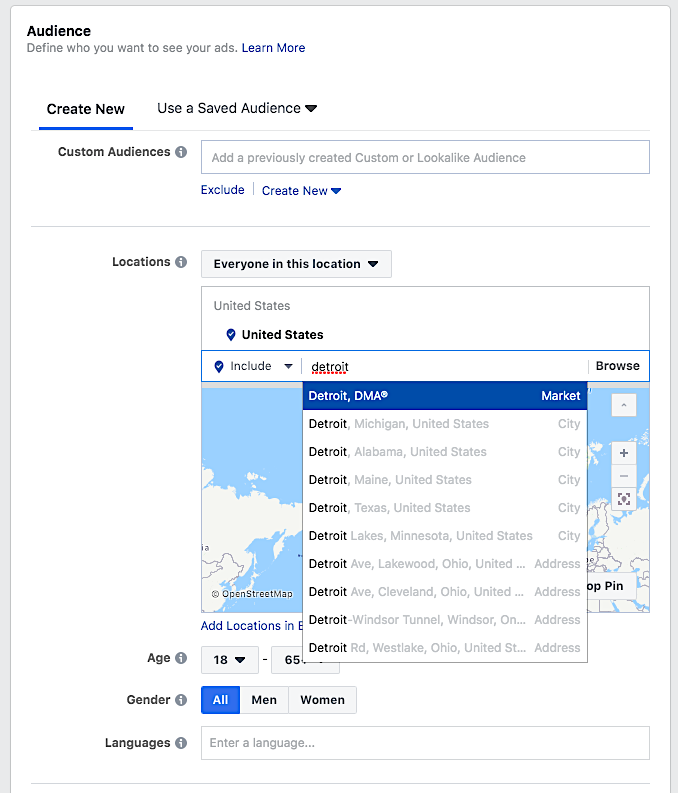
Performance can be measured by installing a Facebook tracking pixel on your website to track conversions. The tracking pixel also gathers data about what type of person is most likely to convert. As it learns, Facebook can then automate your ad delivery to find other people with a similar demographic and interest profile who are likely to convert.
Lastly, if you’re planning to run ads on Facebook, make sure you optimize for mobile since:
94% of all Facebook ad spend happens on mobile.
To maximize your chance of achieving a positive ROI on the platform, you need to be thinking mobile-first when designing your creative, writing your copy, and building your landing pages.
2) Google Ads
Next on our list is the king of search, Google, which offers two advertising options:
A) Google Search Network
Ads on Google’s Search Network appear at the top and bottom of Google’s SERPs, as well as on Google’s search partner sites. These are ideal for getting in front of prospective customers at the exact moment they’re seeking your solution.
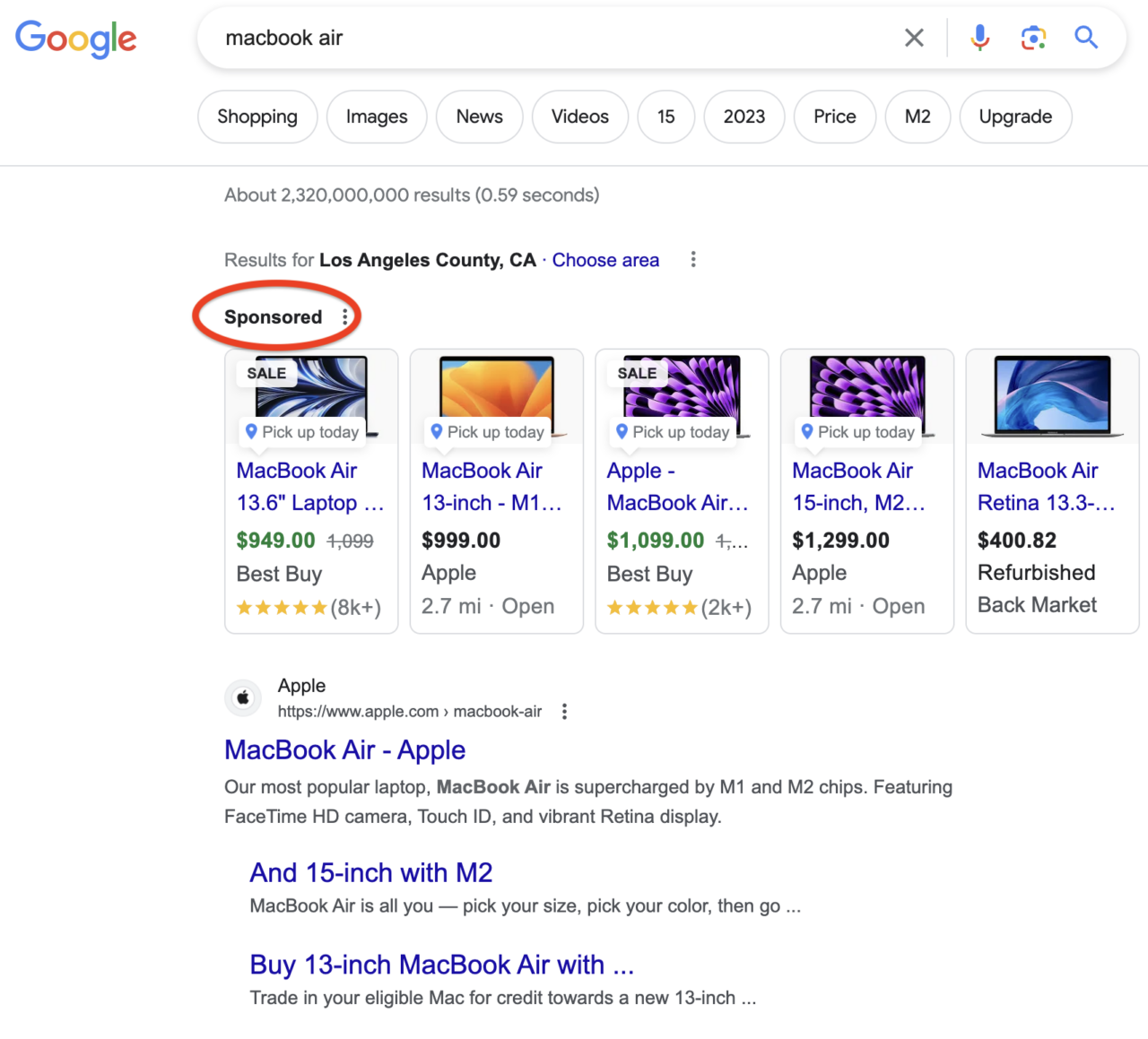
On the Search Network, you can run a variety of text-based ads, including dynamic and responsive search ads. You can also run call-only ads, and shopping ads.
B) Google Display Network
Google’s Display Network lets you place ads on a network of millions of websites that have chosen to sell ad space in their content.
These ads help you get in front of your target market before they start searching for your solution. That means the potential reach is much higher, but the expected click-through rate and conversion rate is lower.
On the Display Network, you can run static image ads, responsive display ads, and video ads optimized for clicks or engagement. You can also place ads in Gmail at the top of the user’s inbox.
3) Bing Ads
As of 2023, Bing has 3.02% of the search engine market share. While that might not sound like a lot, it meant about $11.59 billion in advertising revenue for Microsoft in 2022.
Bing Ads run on three search engines: As well as tapping into Bing’s own audience, your ads can also run on Yahoo! and AOL searches to increase reach.
Although the maximum potential from this platform is lower due to fewer searches, the average cost-per-click is also lower. The exact numbers vary in different verticals, but for example, WordStream found that Bing had an average of 33.5% cheaper CPCs than Google.
4) Instagram Ads
Compared to Facebook, Meta’s other major social media brand, Instagram, typically has a higher CPC, but also higher engagement: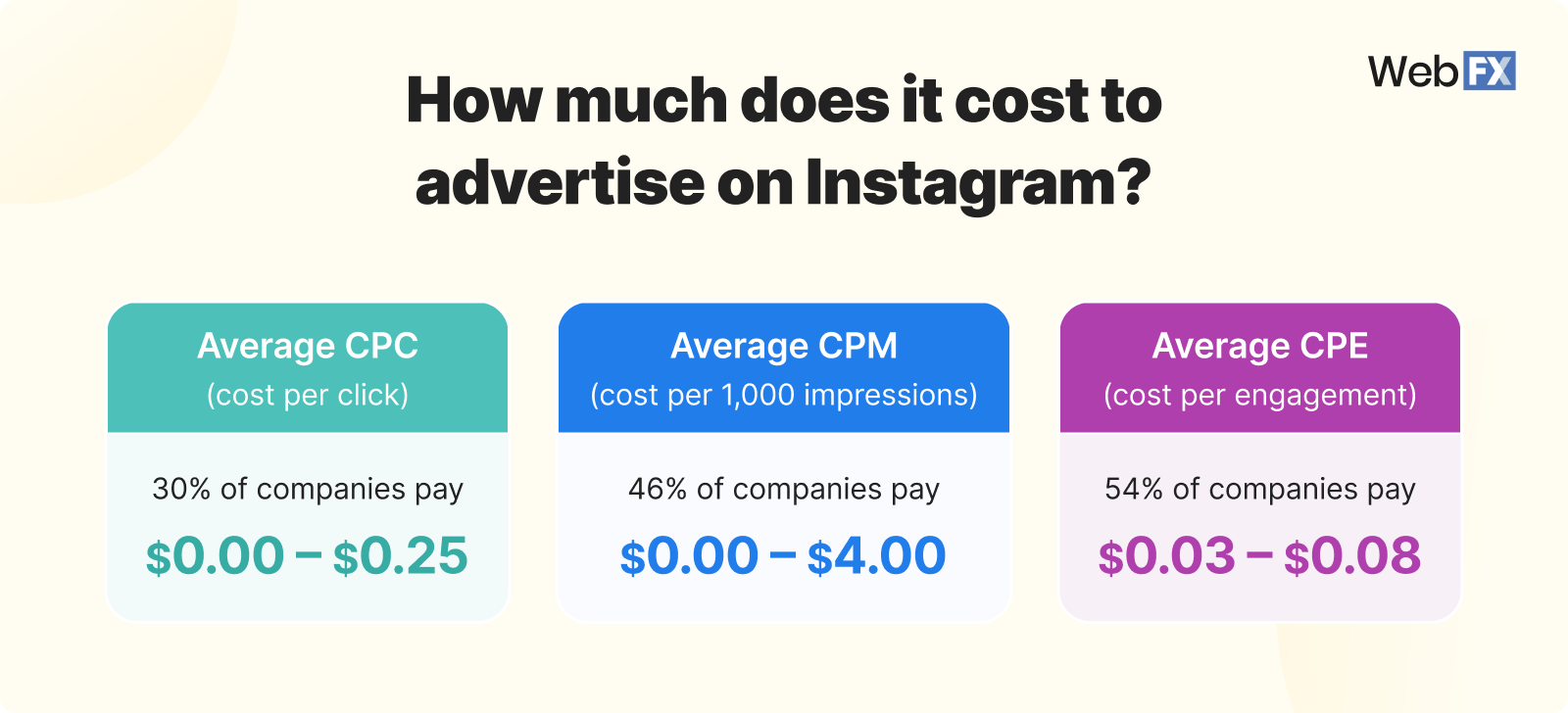 Instagram Ads are created in the Facebook Ads manager, and use the same audience targeting and bidding settings. To create an ad for Instagram, you simply choose Instagram placements (such as newsfeed or story ads) during the ad creation process.
Instagram Ads are created in the Facebook Ads manager, and use the same audience targeting and bidding settings. To create an ad for Instagram, you simply choose Instagram placements (such as newsfeed or story ads) during the ad creation process.
5) X Ads
X, the social media app formerly known as Twitter, generates 90% of its $4+ billion annual revenue from advertising, proving that, despite many recent changes, it’s still a hit with advertisers. On Twitter, you can optimize ad campaigns around objectives such as:
- Website traffic
- Video views
- Engagement
- App installs
- Reach
A variety of Twitter Ad formats are available, including plain text, images, GIFs and videos, with useful optimization tools to help you maximize the value of each ad:

Compared to other social advertising platforms, X’s average cost per click for promoted ads can be low: about $0.25 to $2.
6) LinkedIn Ads
LinkedIn is the premier social network for professionals, so it’s a great place for B2B advertisers to promote their messages. Advertising on the site is self-service and can be targeted by geography, job function, seniority and industry.
It’s one of the only ad networks that lets you target viewers by their role in an organization, and they have the best data on job titles, company size, industry and more. This makes it much easier to build an audience that represents your potential customers.
Even better, they report to you about how your ads are performing on all of those metrics, even if you aren’t targeting them.
LinkedIn Ads’ CPC is, on average, $2-3, and there are four main types of ad placements, most of which are self-serve:
- Sponsored Content. These are posts that show up in the newsfeed, just like you’d see with Facebook Ads.
- Sponsored Messaging. This is when you pay to message people directly in their inbox. It’s essentially simple email marketing for LinkedIn.
- Text Ads. Simple display ads that show above and to the right of the news feed.
- Dynamic Ads. These are also displayed to the right of the news feed, but offer more features that the user can interact with. Only available to clients who spend at least $25,000 in a single quarter (not self-serve).
If you sell a B2B product or service, LinkedIn is definitely a channel you need to check out. To help you out, we’ve created this short video LinkedIn Advertising 101: How to Get Started:
7) Amazon Ads
If you’re an e-commerce entrepreneur with products listed on Amazon, then you’ve undoubtedly heard of Amazon Marketing Services (AMS), a self-serve advertising system through which you can quickly launch three types of PPC ads:
- Headline search ads. These display three or more products at the top of the search engine results pages (SERPs).
- Sponsored products. These appear at the top and bottom of the SERPs with organic listings (like Google Ads). These can also display under the “Related Products” sections at the bottom of other product pages.
- Display ads. These are essentially banner ads that display on the right-hand side of some screens.
The average CPC for Amazon Ads is $0.97.
One bonus is that they allow you to do conversion tracking to see how your ads are performing. This is big because currently there is no way for outside advertisers like Facebook and Google to track conversions post-click.
8) Pinterest Ads
Pinterest has a successful advertising platform, with audience targeting settings available for demographics, interests, keywords and more. Very similar to what you’ll find on Facebook. The average CPC for a Pinterest Ad is about 10¢ to $1.50.
Ads on Pinterest are particularly effective in the early awareness and discovery phases of the decision-making funnel, since Pinterest is often used for discovery, inspiration and new ideas:

If you’re wondering whether your target audience is on Pinterest, the answer is likely to be yes. There are 454 million active users, and that number is growing.
17 Cheapest Ad Networks You Should Definitely Consider
Ready to give a new ad network a try? That doesn’t mean you can’t also use a popular ad network, but if you’re a smaller brand or just getting starting with advertising, we suggest you give these ones a try.
We’ve compiled this list of 22 of the best ad networks that serve as a solid alternative to the big name advertising platforms.
1) TikTok
TikTok is a video-sharing mobile app that surged in popularity in recent years. This platform has a predominantly Gen-Z audience, but the number of older uses is rising, too.
If you’ve used Facebook Ads, the TikTok Ads manager will feel quite familiar in terms of campaign setup, audience targeting, billing events and conversion tracking. Also similar to Facebook, TikTok uses a tracking pixel to help with measuring website performance.
TikTok has a minimum ad spend of $500. The platform bases its prices on a CPM (Cost Per Mile – otherwise known as Cost Per Thousand) model, with ads typically costing $10 per CPM. To reach 100,000 ad views, this would cost $1,000.
Here’s a list of placements available.
2) YouTube
YouTube advertisers can use the service to run highly engaging display or overlay ads in videos, in addition to targeting the people viewing your ads by demographics, topics, keywords and interests.
Despite being a Google product, YouTube prices its advertising options differently to search and display network ads. Ads typically have a Cost Per View (CPV) of between $0.10 – $0.30 with no minimum ad spend requirement.
This makes it a good option for those starting out on a limited budget. However, it does work out more costly in the long-run compared to other platforms, with the average cost of 100,000 YouTube ad views coming in at around $2,000.
One great thing is how they count views compared to most platforms. On YouTube, a view is only counted when someone watches at least 30 seconds or completes your video (whichever comes first). But since it’s so large, it’s also a bit more complicated with tons of targeting features and display formats.
3) Opt-Intelligence
Opt-Intelligence is a unique platform that charges per lead rather than per impressions or click-throughs as is standard in the world of PPC.
Prices vary depending on industry and audience demographics, though the average Cost Per Lead (CPL) is around $1.50 for general consumers. Some industries, such as financial investing, can be much higher, with average rates starting around $8 per lead.
This makes it a significantly good deal when you consider that the average conversion rate for PPC is 2.35%.
To get 10 leads from Opt-Intelligence at an average of $1.50 per lead, you’d spend $150. To get 10 leads from Google Ads, for example, you’d need to spend around $638 (based on an average Cost Per Click of $1.50).
4) OddBytes
OddBytes, formerly Propel Media, is arguably the most popular pay per view (PPV) advertising solution in the world.
Use it to reach customers through contextual text links and display ads. OddBytes makes the platform as effortless as possible with visualized analytics that help you to monitor trends and editing features that help you easily edit your campaigns.
Pricing models depend on the type of ads you run. Text links are served using a CPC model with a minimum bid of $0.05 per click, while display and lightbox ads have a minimum bid of around $0.10 per 1,000 views:


5) Taboola
Taboola specializes in native ads.
They claim to have wider reach than Outbrain and other native ads providers, including ad placements on the following publishers in the Taboola network: The Motley Fool, The Atlantic, Ben & Jerry’s and Netflix.

The company offer both CPM and CPV pricing models which are among the most affordable in the industry. It’s not uncommon to get CPCs of around $0.60 on desktop and just $0.30 for mobile ads.
The only downside is that the company requires a minimum campaign budget that is 30X the amount of your bid. So, if you bid $0.40, for example, you’d need a minimum ad spend budget of $12. Still, that’s very reasonable compared to some minimum budgets required by other platforms.
6) BuySellAds
Operating since 2008, BuySellAds (BSA) offers advertisers a mix of display ads, media buys, sponsored content and custom unit opportunities. They work with 1,500+ well-known publishers like the Atlantic, NPR and PBS, and have plenty of success stories:

BSA’s CPM rates average around $0.25 – $0.75, making them undoubtedly one of the cheapest Google Ads alternatives out there.
7) Ad Recover
Ad Recover is an top ad network that works by recovering your ad blocked inventory. Because of this, the network is able to monetize this in a way other publishers are not able to, which gives you a larger range of publishers to deploy your ads on, despite the rise of ad blockers.

What’s more, CPMs average around $0.50 per 1,000 views, making it highly competitive in the cost stakes.
8) Ad Maven
Ad Maven has additional monetization strategies, including banner ads, light boxes, interstitial ads and slider ads.
This company serves hundreds of millions of impressions in over 200 countries, so advertisers have a wide range of options when it comes to geotargeting. One of the key elements that separates them is a well-constructed RTB (real-time bidding) system, which helps them give you precise targeting with your ads.
The platform requires a minimum deposit of $25 and minimum campaign budget of $10, though their highly competitive CPC and CPV rates ensure they remain one of the cheapest PPC advertising networks to work with.
9) AdRoll
AdRoll is an advertising platform that offers retargeting and multi-device display advertising services. Their retargeting feature is available for ads on Facebook, Twitter and countless other sites, while their staff offers excellent support to help you leverage retargeting to its fullest potential.
Pricing plans start at $36 per month, though a custom Pay-As-You-Go model is also available:

Check them out if you’re new to retargeting and need some hand-holding to help get you up to speed.
10) MediaVine
MediaVine is an advertising service that focuses on influencer marketing and programmatic advertising.
Their inventory includes thousands of sites, with a reach of 125 million monthly unique visitors, with particularly good reach in the lifestyle niche. For both advertisers and publishers, they offer fully managed services to help you maximize the effectiveness of your campaigns.
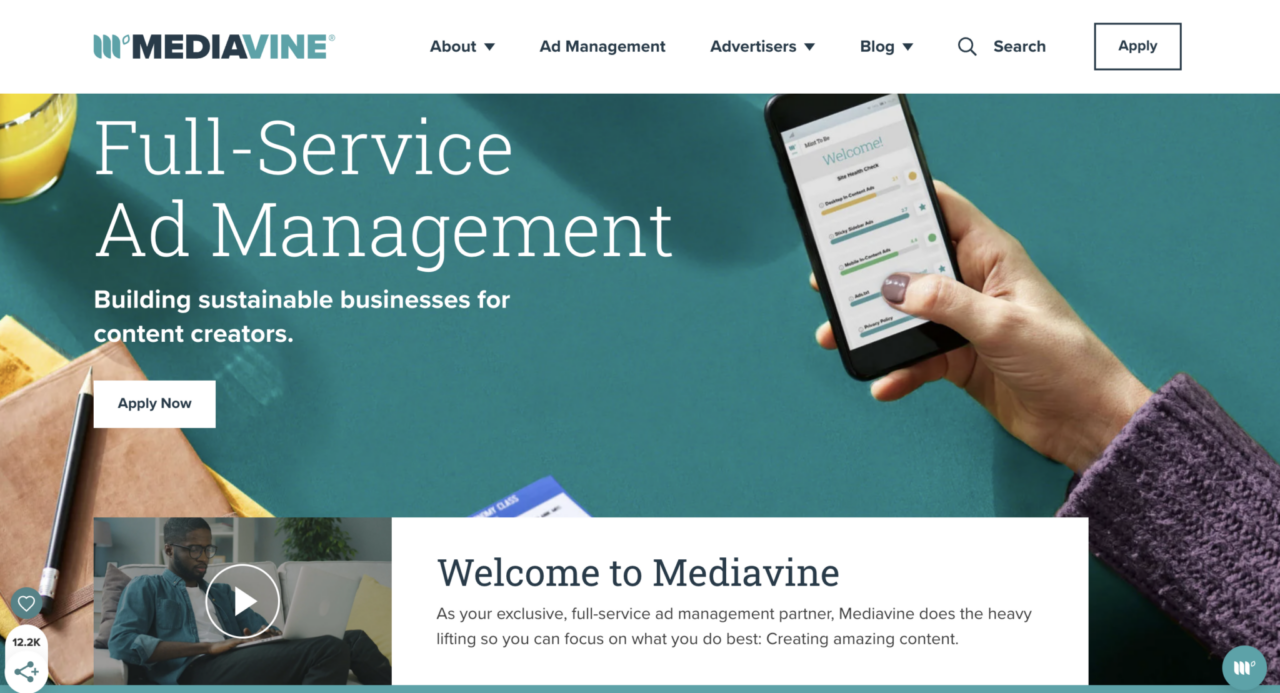
The platform has a $100 minimum ad spend requirement with average CPC rates ranging from $0.50 to $2, making it a competitive alternative to Google Ads.
11) Adblade
Adblade is a content-style ad platform that advertisers can use to deploy their content to specific target audiences across the web. They’ve got a variety of big name publishers on their network, including Fox News, ABC, Yahoo, and 1,000 other branded sites.
They’re vigilant about screening which websites they allow onto the platform, which means that you won’t have a bad ad placement on a site that you don’t want to be associated with.
Adblade requires a minimum ad spend of $50, after which average CPC rates range from $0.50 to $1.
12) Epom
The Epom ad server lets advertisers reach customers with display, video and mobile app ads. One of the unique selling points of the Epom Ad Marketplace is that they offer a 30-day trial through which you can receive up to 1 billion free impressions.

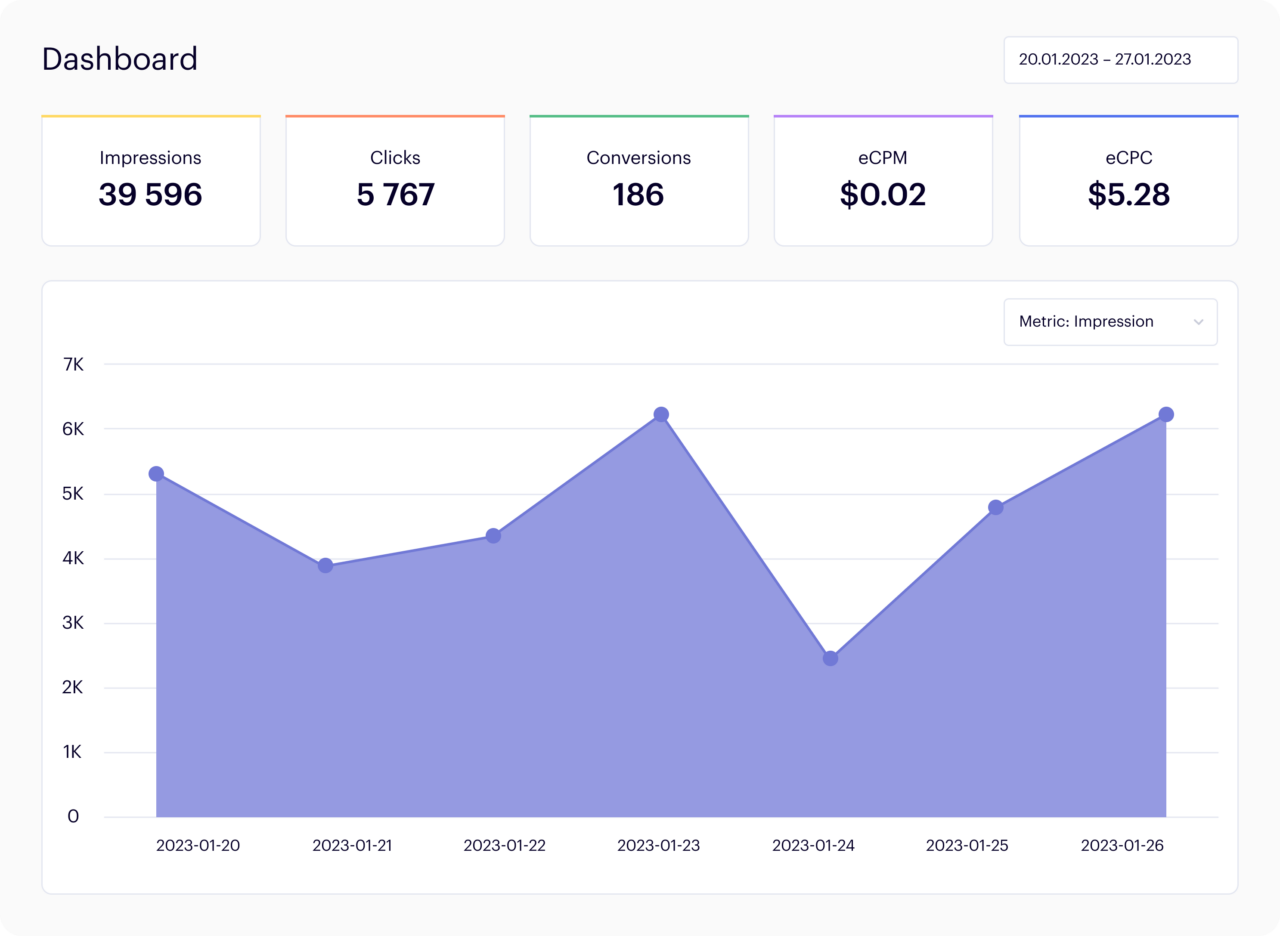
After the free trial is over, plans range from $212 for 8.5 million display and mobile web impressions per month up to $2,125 per month for 150 million impressions. These pre-packaged ad services offer a great alternative for those who want to eliminate the guesswork when it comes to their monthly ad spend.
13) Spotify
Over the past decade, Spotify has taken the music industry by storm. Boasting over 220 million subscribers, it’s one of the largest streaming companies on the market. Of the 551 million monthly active users, over half of their users (331 million) have a free account, which means they pay for the service through advertising.

Spotify Ads are broken into four main categories:
- Audio
- Display
- Video
- Podcast
- Sponsored playlist
You can start advertising on Spotify for as little as $250, with a minimum daily budget of $1. Average ad impressions are between $0.015 and $0.025.
14) Snapchat
Snapchat is a social media mobile app. It is designed so that, by default, when you share an image or a video, it is only available for a short amount of time.
Snapchat has one of the lowest minimum spend requirements in the industry at just $5. However, the company do recommend that you spend at least $20 to generate any significant return on your investment.

Snapchat’s CPC are on the higher side, around $1 – $3 per click, though given that it presents a tremendous opportunity to get your brand in front of a large and predominantly young audience, this does make the popular social media app a worthwhile ad alternative for those targeting the youth demographic.ore.
15) Reddit
Reddit boasts a gigantic audience with loyal and active communities dedicated to just about every niche and topic of interest.
That alone should hold some appeal to budget-savvy advertisers, though if that’s not enough to convince you, the fact that Reddit advertisers typically enjoy 27% better conversions might.
Here, you can choose from either a daily minimum budget of $5 or a minimum lifetime budget of $160, with average CPCs comparable to Google:

16) SmartyAds
SmartyAds offers a programmatic media buying platform (DSP) that connects advertisers to premium global publishers, SSPs, and leading PPC ad networks who attract various types of audiences.
These audiences can be easily tracked with cross-device and cross-channel targeting options tuned up in self-serve DSP dashboard. Targeting narrowly, advertisers show ads only to the relevant audience, eliminating expenditures on ineffective impressions.
What makes SmartyAds such a great option for budget-conscious advertisers is their Adaptive CPM model. Using this model, you set a budget cap and then launch your ads. The Adaptive CPM ensures that you never spend more than your cap while also keeping every bid at the most competitive level to ensure maximum ROAS.

The ad formats are rewarded video, interstitial, native banner, CTV, audio and DOOH, and the average CPM is $10 to $25.
17) Vibrant Media
Vibrant Media is an ad network that helps advertisers place their content on over 6,600 premium publisher sites. They have a variety of ad formats available, including in-text, in-image, lightbox, storyboard, and mosaic. Some of the features they offer advertisers are:
- Native ad placement. Vibrant can place your ad in the middle of premium content on different publisher sites so that it gets seen by an engaged audience, and so that you establish consumer trust.
- Real-time targeting. Vibrant analyzes the content that your ad appears in, so that it also appears in the right context.
- Designed to engage. Vibrant takes branded content and deploys it in such a way that it tells your brand’s story through interactive experiences.
The company charge custom rates depending on your circumstances, though they are competitive compared to the likes of Google and Facebook Ads.
Which Factors to Consider When Choosing Other Ad Networks
There are many excellent cheaper ad networks to choose from, but which one is best for your business model?
Unfortunately, there’s no clear answer to that question, as there are so many different factors that come into play. Here are a few variables you’ll want to take into consideration as you make your decision:
The Devices Your Customers Are Likely to Use
In 2023, the question is no longer “is mobile marketing important?” but rather “mobile marketing is important; now how do I take advantage of it?” People still use different devices for different reasons.
So when selecting an ad network, it’s crucial to consider the devices your customers primarily use. Different ad networks may specialize or perform better on certain devices, influencing where and how your ads are displayed. Here’s why this is important:
- Mobile vs. Desktop Users: The divide between mobile and desktop users can greatly affect ad engagement. For instance, if your target audience predominantly uses mobile devices, choosing an ad network with a strong presence and optimized ad formats for mobile platforms is essential.
- App vs. Web Browsing: Understand whether your customers spend more time in apps or browsing the web. Some ad networks specialize in in-app advertising, which could be more effective if your audience engages more with mobile apps.
- Screen Size and Ad Format: Different devices have varying screen sizes, which can affect the visibility and engagement of your ads. Ad networks that provide responsive ad formats, which adapt to different screen sizes, can ensure a more consistent and effective ad experience.
- Operating System Considerations: The operating system (iOS, Android, Windows, etc.) can influence ad performance. Some ad networks may offer better targeting or ad formats for specific operating systems.
- User Behavior and Device Preferences: Understanding the typical behavior of your audience on their devices is key. For example, younger demographics might be more engaged with ads on social media apps on smartphones, while a business-oriented audience might respond better to ads on professional networking sites accessed via desktop.
The Targeting Options Available to You
Today’s ad networks offer much more sophisticated targeting options than ever before, such as geographic location, demographic data, device, income and other elements. Some also include retargeting features, which enable you to put your ads in front of customers who have already visited your website.
This is an incredibly valuable option, as conversion rates on retargeted traffic can be double that of standard advertising. Familiarize yourself with the different options each network allows before deciding which is most appropriate for your goal.
Run-of-Network Options
Many of the ad networks listed above allow you to have your ads placed on random websites in their inventory. There are pros and cons to this option:
- The downside is that your ads may not be displayed on the highest quality or most relevant sites in the network.
- The upside is that this can be an efficient way to test multiple sites to see which ones are consistent with your branding and traffic goals.
The Relevance of the Network’s Niche Publishers
Large ad networks typically work with thousands of different publishers. Try to find out which publishers are in their inventory and see if they’re relevant to your target audience. Remember, there’s no point running ads on websites that your target demographic isn’t viewing.
Last Word on Using Cheaper Ad Networks
There are many different factors that you need to take into consideration when determining where to run your ads. Since testing a new network requires an investment of both time and money, it’s important that you figure out which of these chepaer ad networks (or any, really) are best suited for your business first.
That said, remember that you aren’t required to stick with the first ad network you test. If you’ve given a network a good try but aren’t seeing the results you need, don’t be afraid to pick another option from this list and try your luck elsewhere.
If you’re ready to get the maximum return on your online advertising investments, Single Grain’s ad experts can help!👇
Additional content contributed by David Borgogni.
Ad Networks FAQs
-
What is the cheapest ad network?
According to our research, X (formerly Twitter) and YouTube are among the lowest-cost networks for advertising. TikTok Ads are also cheap, though the high $500 minimum ad spend may be off-putting to some.
-
Which platform has the lowest CPM?
Lightbox ads via Oddbytes ($0.10c per 1,000 views) make it the advertising platform with the lowest Cost Per Million.
-
Which ad networks have no minimum traffic?
Media.Net, PropellerAds, and PopAds are all ad networks with no minimum traffic requirements, making them ideal for small publishers.
-
Do ad networks still exist?
Absolutely. Since their roots in the 1990s, ad networks have always been around in some form. In the last two decades, they have evolved a lot, with new audience targeting methods, new ad formats, and sophisticated tracking.
When it comes right down to it, though, an ad network is still fundamentally the same: They connect publishers with those who wish to get in front of their audience.
-
What are alternative ad networks?
When you think of an ad network, chances are the first ones that come to mind are the big players: Facebook, Google, YouTube, Amazon, and so on. An alternative ad network is one which is simply less well known (sometimes because they’re new ad networks, sometimes because they’re just small platforms), and is therefore used by fewer advertisers.
Alternative ad networks can often yield superior results compared to popular channels. Fewer advertisers means lower costs with auction-based bidding, and you may find a network with a highly relevant niche audience, too.
-
How do advertising platforms work?
Digital advertising platforms deal with two main stakeholders: content producers (usually website owners) and advertisers.
The advertising platform connects the two parties so that the content creator can monetize their site by selling ad space, and the advertiser can pay to get in front of the right audiences.
-
What is the best advertising platform?
When it comes to choosing an ad platform, there isn’t a one-size-fits-all approach. Every platform is different. You should research the audiences that each network has, and find one that aligns with your campaign and business objectives.
For example, if you’re looking to raise brand awareness for a wedding dress company, Pinterest is likely to be a great bet. If you’re looking to generate inquiries for a local emergency locksmith, Google or Bing search ads are likely to be best.
-
Which is better, Facebook Ads or Google Ads?
It depends on your goals.
With Google Ads, the advantage is that you get in front of searchers at the exact time that they’re looking for your solution. This carries a higher average cost per click, but high intent and high conversion rates.
With Facebook Ads, you have a much wider audience to advertise to. You aren’t waiting for the person to search; you can proactively get in front of your target market. You have a lot of audience targeting methods at your disposal, such as demographic and interest targeting, lookalike audiences, retargeting, and more.
Test each method, and scale up the one that gets the best results in your unique circumstances. Or take a look at this article for more inspiration: A Simple Hack to Combine Facebook Ads and Google Ads



